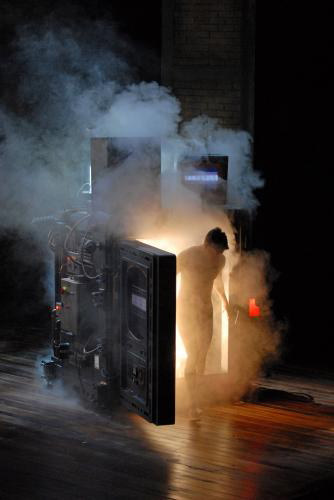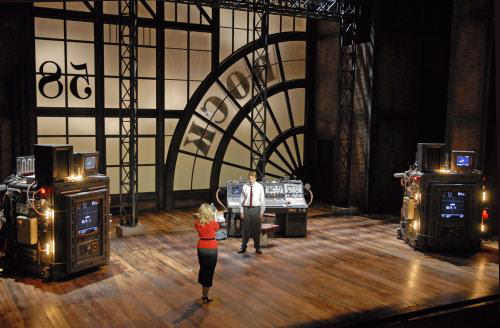Other Links
Editorial Board
- Editor - Bill Kenny
- London Editor-Melanie Eskenazi
- Founder - Len Mullenger
Google Site Search
SEEN
AND HEARD INTERNATIONAL OPERA REVIEW
Howard Shore, The Fly: Soloists,
chorus and orchestra of Los Angeles Opera, Placido Domingo,
conductor; Dorothy Chandler Pavilion, Los Angeles. 7.9.2008 (HS)
Those who know David Cronenberg's 1986 film "The Fly" probably
remember mostly its gore. The title character, a mad scientist
played by Jeff Goldblum, gradually transforms into a gigantic
insect, losing fingernails and various appendages in several
memorable "yuck" moments. But there's a story of human emotions in
the film as well, as the scientist and a pretty science reporter,
played in the film by Geena Davis, struggle to come to grips with
their own love story and its consequences.
The story is set in the 1950s. The curtain rises on a laboratory
littered with piles of trash. A police detective interviews
Veronica, who begins to tell the tale. The laboratory remains
through scene changes accomplished by wheeling in desks, chairs,
hospital beds, and at one point a billiard table and some table
settings to represent a bar. Veronica meets Seth Brundle, an
introverted scientist, at a party for her magazine's awards. He
shows her what he's working on—teleportation—and successfully
teleports one of her stockings from one "pod" to another in the
laboratory, but a later attempt to make it work with a monkey fails.
Cast:
SETH BRUNDLE, Daniel Okulitch
VERONICA QUAIFE, Ruxandra Donose
STATHIS BORANS, Gary Lehman
OFFICER/MEDICAL ANALYST/CHEEVERS, Beth Clayton
MARKY, Jay Hunter Morris
TAWNY PERKINS, Ashlyn Rust
Production:
LIBRETTIST, David Henry Hwang
DIRECTOR, David Cronenberg
SET DESIGNER, Dante Ferretti
COSTUME DESIGNER, Denise Cronenberg
LIGHTING DESIGNER, AJ Weissbard
ASSOCIATE CONDUCTOR/CHORUS MASTER, Grant Gershon
MAKEUP AND CREATURE DESIGN, Stephan L. Dupuis
MAKEUP, CREATURE AND PUPPET FABRICATION, Mark Rappaport's Creature
Effects, Inc.

Sounds like great stuff for an opera, doesn't it? Los Angeles Opera
thought so, too, and co-commissioned one. It made its U.S. debut
Sunday with Placido Domingo conducting and Cronenberg directing (the
first performances were in July at Theatre de Châtelet in Paris).
The results seem surprisingly tepid.
As in many horror films, the music provides much of the visceral
emotional impact. Howard Shore wrote it, and has since gone on to
write the scores for other films, including 12 of Cronenberg's ("M.
Butterfly" and "Eastern Promises" among them). He got several Oscars
for "Lord of the Rings." With those credentials, a new opera on "The
Fly" by Shore, using some of the material from the film and a
libretto by David Henry Hwang, should have been a wow.
Unfortunately, what makes Shore such a superb film composer doesn't
translate to opera, or at least not this one. His music can create a
mood, underline a moment or suggest a fleeting emotion without
getting in the way of a film's prime reason for being: the visual
narrative. In opera, the music must carry the narrative, or it's
just a play with good background music. And that's pretty much what
we have in "The Fly." Shore's music just isn't strong enough to
carry the narrative. Hwang's libretto, alternately too prosaic or
grandiose, doesn't do it either.

As they fall in love, culminating in an onstage sex scene, Brundle
figures out how to make the teleportation process work with flesh.
He transports the monkey, but then with Veronica away to break off
an old affair with her boss, Stathis, Seth impulsively transports
himself. An unseen but loudly heard fly gets into the pod with him
and scrambles their DNA. End of Act I.
Although Seth is the title role, Veronica is the pivotal part.
Romanian mezzo-soprano Roxandra Donose, looking slim and sexy her
tight-fitting 1950s outfits, has the stage presence and musical heft
to flesh out the character. She has two big scenes, and delivers
them with power. But they got a tepid response from the audience
because they come after too many scenes of nothing but parlando and
recitative. The first 40 minutes of the opera is nothing but scene
setting. The music just never opens up vocally.
Daniel Okulitch wielded a sweet lyric baritone as Seth, but lacked
power in the lower register, which weakened the character. In the
first act he played the role with such a lack of personality that it
took away from the narrative. He got stronger in the second act.
Gary Lehman, who recently sang Tristan at the Met, sang powerfully
as Sathis, the editor and third member of the love triangle. But
Shore's music never gave him a signature moment or something
recognizably different to define his character. Mezzo Beth Clayton
made her usual fine impression but in multiple thankless roles. In a
brief episode, Seth breaks the arm of Marky, a strongman (Jay Hunter
Morris, another Wagnerian tenor), and captures a young hotty
(soprano Ashlyn Rust) to satisfy his lust when Veronica tires.
In general, the staging managed to stop short of becoming too hokey.
High marks too for the puppeteers who designed and manipulated the
monkey, a winsome little capuchin) and in the final scene the
distorted body of Seth as the fly. There was also some nice
stagecraft to show the suddenly virile Seth tumbling and flipping
around, and eventually climbing the walls and ceiling.
The chorus did its part, too, portraying partygoers and bar
denizens, but mostly voicing the computer in Seth's lab. But all
those grandiose "new flesh" lines needed more musical underpinning
than Shore provided. As purely instrumental music, the scene setting
and interludes are highly listenable and effective. Domingo and the
orchestra gave them plenty of thrust, but things work less well when
combined with voices. Not a good thing for an opera.
In a story that could play well in a comic book, Cronenberg's movie
making and Shore's music gave the film some unexpected depth. As an
opera, not so much.
Harvey Steiman
Pictures
© Marie-Noelle Robert
Back
to Top
Cumulative Index Page
